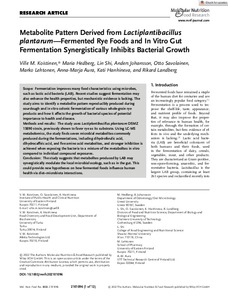Metabolite Pattern Derived from Lactiplantibacillus plantarum-Fermented Rye Foods and In Vitro Gut Fermentation Synergistically Inhibits Bacterial Growth
Koistinen Ville M.; Hedberg Maria; Shi Lin; Johansson Anders; Savolainen Otto; Lehtonen Marko; Aura Anna-Marja; Hanhineva Kati; Landberg Rikard
https://urn.fi/URN:NBN:fi-fe2022091258637
Tiivistelmä
Scope
Fermentation improves many food characteristics using microbes, such as lactic acid bacteria (LAB). Recent studies suggest fermentation may also enhance the health properties, but mechanistic evidence is lacking. The study aims to identify a metabolite pattern reproducibly produced during sourdough and in vitro colonic fermentation of various whole-grain rye products and how it affects the growth of bacterial species of potential importance to health and disease.
Methods and results
The study uses Lactiplantibacillus plantarum DSMZ 13890 strain, previously shown to favor rye as its substrate. Using LC-MS metabolomics, the study finds seven microbial metabolites commonly produced during the fermentations, including dihydroferulic acid, dihydrocaffeic acid, and five amino acid metabolites, and stronger inhibition is achieved when exposing the bacteria to a mixture of the metabolites in vitro compared to individual compound exposures.
Conclusion
The study suggests that metabolites produced by LAB may synergistically modulate the local microbial ecology, such as in the gut. This could provide new hypotheses on how fermented foods influence human health via diet–microbiota interactions.
Kokoelmat
- Rinnakkaistallenteet [27094]
